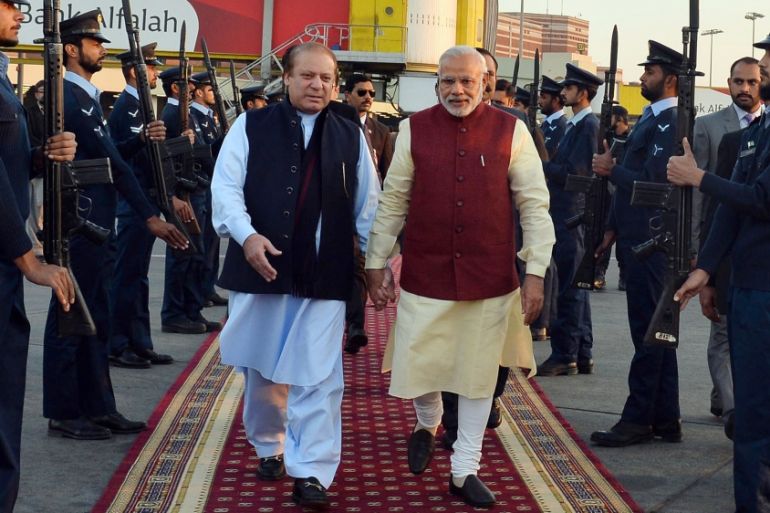Economics defines India-Pakistan rapprochement
Since the Mumbai attacks in 2008 several attempts to restart the stalled process have come to naught.

Indian Prime Minister Narendra Modi, who is acquiring quite a reputation as an intrepid traveller, usually embarks on his foreign tours on board a Boeing 747 Jumbo.
It was interesting, therefore, to see him arrive in the Pakistani city of Lahore, resplendent with Mughal-era gardens and buildings, in a much smaller plane for what seemed to be a jumbo stride in trying to mend ties with the long-term South Asian adversary.
Keep reading
list of 4 items‘We need you’: Solomon Islands’ support for US agency’s return revealed
Why are nations racing to buy weapons?
Parallel economy: How Russia is defying the West’s boycott
Modi announced his intent to make a stopover in Lahore on Christmas Day as he was to head home from Kabul after inaugurating the war-ravaged parliament building in the Afghan capital his country helped to rebuild.
What appeared to be a hastily arranged welcome was set up by his Pakistan counterpart Nawaz Sharif, who was in Lahore to celebrate his own birthday and his granddaughter’s wedding.
The visit, which lasted a couple of hours, provided excellent optics as the two leaders embraced warmly, walked hand in hand at the airport and wore smiles on their faces.
In a series of tweets on reaching home, Modi said he greatly appreciated Sharif for personally receiving and seeing him off at the airport – on a non-state, unofficial visit.
Long-standing disputes
Relations between the two countries have been dogged by the dispute over the Kashmir region, which dates back to the partition of India in 1947 after the British decided to leave.
Pakistan has a long-running claim over the Indian-controlled part of Kashmir. The two countries have fought three wars since independence, two of which were over Kashmir.
Since an uprising in Kashmir after a rigged election in 1987 turned into a full-blown separatist insurgency, New Delhi has accused Islamabad of fanning the flames by training and sending militants to the valley to take on the Indian security forces.
OPINION: India and Pakistan must compromise over Kashmir
Pakistan consistently denies these allegations but few in the international community believe it. In turn, Pakistan accuses Delhi of making attempts to destabilise it using proxies in Afghanistan.
After peace overtures alternated with tense standoffs over several decades, relations hit rock bottom when terrorists, reportedly 10 in number, allegedly belonging to Pakistan-based Lashkar-e-Taiba, carried out multiple suicide attacks in the Indian commercial capital of Mumbai in November 2008.
The attacks on a train station, a couple of hotels, restaurants and other randomly chosen targets left at least 160 people dead, mostly civilians.
Nearly 1.4 billion people inhabit the two traditional South Asian rival countries alone, and with their growing economies and energy needs, and the need for newer, more diverse markets and trading opportunities, the future of the troubled region once defined by conflict may well be defined by common economic interests.
Since then, several attempts to restart the stalled process have come to naught.
Where Pakistan appeared adamant to discuss Kashmir first and then other issues, India now signalled what it saw as terrorism at the behest of its western neighbour as the number-one issue between them.
When Sharif decided to attend the inauguration of the reputedly hardliner Hindu nationalist Modi in May 2014, hopes were renewed of a thaw in relations, but soon bloody skirmishes broke out along the Line of Control in Kashmir which divides the disputed region into Indian and Pakistani-controlled areas.
These skirmishes were accompanied by rising angry rhetoric in Delhi.
Questions remain
Even when images of the two leaders caught in a brief yet seemingly intense chat appeared in the media from the Paris Earth summit last month, few would have imagined the pace at which efforts towards normalisation would proceed.
Just three weeks ago, on December 7, the national security advisers to the two prime ministers met in Bangkok for a meeting that took the media by surprise. Their five-hour meeting took matters forward as three days later the Indian Foreign Minister Sushma Swaraj arrived in the Pakistani capital to attend a conference between Kabul and Islamabad on Afghanistan.
She stole the limelight from the conference discussions by announcing that her country and Pakistan had decided to restore an all-encompassing bilateral dialogue which would include terrorism and Kashmir.
This statement came as a huge relief to those who were alarmed at reports that the Indian military was trying out its “cold start” doctrine, aimed at achieving rapid mobilisation to carry out surprise “punitive” attacks across the border in Pakistan.
The relief was also felt after there had been news reports of rapid production of tactical nuclear warheads and delivery systems by Islamabad to counter the numerically superior Indian military.
OPINION: The China-Pakistan corridor – a fate-changer?
Question marks over the sustainability of the process remain. Analysts are asking what will happen if, for example, another terrorist attack on Indian soil is traced to militants across the border.
On the flip side, what is fuelling optimism is the huge peace dividend. Just this month the two countries joined Turkmenistan and Afghanistan in the ground-breaking ceremony of a natural gas pipepline called TAPI which will bring Turkmen natural gas via Afghanistan and Pakistan to India.
Then, the Iran leg of the Iran-Pakistan-India oil pipeline had already been built, and the rest is likely to be completed within a couple of years once United Nations sanctions on Tehran are lifted.

Pakistan has also concluded a $46bn China-Pakistan Economic Corridor aimed at connecting the underdeveloped western region of China to Gwadar Port on Pakistan’s Balochistan coast just south of the Hormuz Straits.
The pro-business Indian prime minister, addressing the opening of the parliament building in Kabul, called upon Pakistan to serve as a bridge between South Asia and Central Asia.
Nearly 1.4 billion people inhabit the two traditional South Asian rival countries alone, and with their growing economies and energy needs, and the need for newer, more diverse markets and trading opportunities, the future of the troubled region once defined by conflict may well be defined by common economic interests.
It appears that even Pakistan’s military, which has traditionally taken a tough, hard line on India, has begun to understand this.
Abbas Nasir is a former editor of Pakistan’s English language newspaper Dawn and former executive editor at BBC Asia-Pacific region.
The views expressed in this article are the author’s own and do not necessarily reflect Al Jazeera’s editorial policy.
